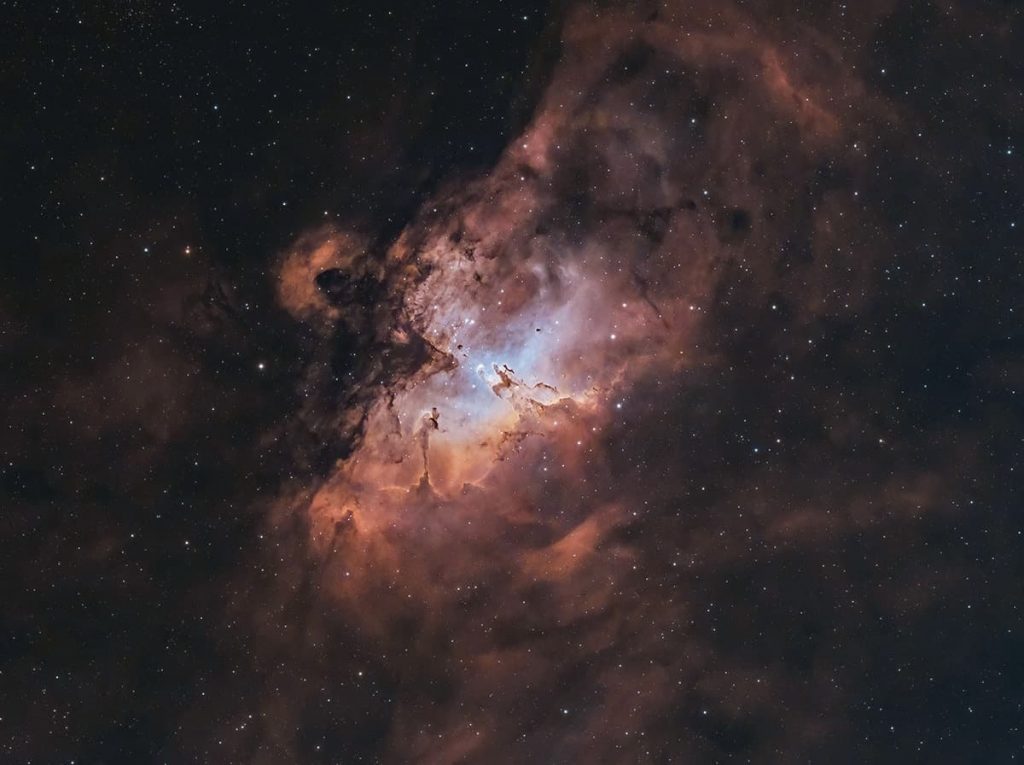Your cart is currently empty!

Exploring the Eagle Nebula: A Cosmic Marvel
The Eagle Nebula, also known as Messier 16 (M16) or NGC 6611, is one of the most iconic and studied star-forming regions in our galaxy. Located about 7,000 light-years away in the constellation Serpens, this breathtaking nebula captivates astronomers and stargazers alike with its towering pillars of gas and dust, vibrant colors, and fascinating stellar nurseries.
What is the Eagle Nebula?
The Eagle Nebula is a massive cloud of interstellar gas and dust that serves as a stellar nursery, where new stars are born. It spans roughly 70 by 55 light-years and is part of a larger star cluster, NGC 6611, which contains many young, hot stars. The nebula’s most famous feature is the “Pillars of Creation,” towering columns of cold gas and dust where intense ultraviolet light from nearby stars triggers the formation of new stars.
The Pillars of Creation
Captured in stunning detail by the Hubble Space Telescope in 1995, the Pillars of Creation are perhaps the most recognizable image of the Eagle Nebula. These pillars are about 4 to 5 light-years tall and are composed primarily of molecular hydrogen and dust. The intense radiation from nearby young stars erodes the pillars, compressing gas at their tips, leading to the birth of new stars inside these dense regions.

Image credit: NASA, ESA/Hubble
Star Formation and Stellar Winds
The Eagle Nebula is a hotbed of star formation, with newborn stars illuminating the surrounding gas and dust. Ultraviolet radiation and stellar winds from these young stars sculpt the nebula, creating intricate shapes and triggering further star formation. This dynamic environment offers astronomers insights into the process of stellar birth and the lifecycle of interstellar clouds.
Observing the Eagle Nebula
Although the Eagle Nebula is a popular target for professional telescopes, amateur astronomers can also observe it with medium to large telescopes under dark skies. It appears as a faint patch of nebulosity in the constellation Serpens, near the bright star cluster NGC 6611. Using long-exposure astrophotography, enthusiasts can capture the nebula’s intricate structures and vibrant hues.

Image credit: NASA, ESA/Hubble
Scientific Significance
The Eagle Nebula has been instrumental in advancing our understanding of star formation, the interaction of radiation with molecular clouds, and the evolution of young star clusters. Its dramatic features and ongoing stellar activity make it a natural laboratory for astrophysics research.
Conclusion
The Eagle Nebula stands as a testament to the beauty and complexity of our universe. From the majestic Pillars of Creation to the bustling star-forming regions, it continues to inspire curiosity and wonder. Whether viewed through the lens of a telescope or in stunning images from space observatories, the Eagle Nebula invites us to explore the cosmic processes that shape the stars and, ultimately, the galaxies.
For those interested in seeing this celestial wonder, the Eagle Nebula is best viewed during the summer months in the Northern Hemisphere. Grab your telescope, find a dark sky, and journey to the Eagle Nebula — a true masterpiece of the cosmos.


Leave a Reply